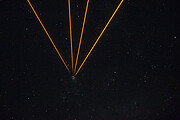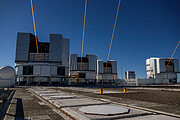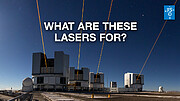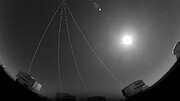Comunicato Stampa
La sperimentazione laser apre una nuova era dell'interferometria
10 Novembre 2025
La scorsa settimana, quattro laser sono stati proiettati nei cieli sopra il sito del Paranal dell'ESO (Osservatorio Europeo Australe) in Cile. Ogni laser viene utilizzato per creare una stella artificiale, che gli astronomi utilizzano per misurare e quindi correggere la sfocatura causata dall'atmosfera terrestre. Il lancio suggestivo dei laser, uno da ciascuno dei telescopi da otto metri del Paranal, rappresenta una pietra miliare significativa del progetto GRAVITY+, un ampio e complesso aggiornamento del VLTI, l'interferometro del Very Large Telescope, dell'ESO. GRAVITY+ libera una maggior potenza osservativa e una copertura del cielo molto più ampia per il VLTI rispetto a quanto possibile in precedenza.
"È un traguardo molto importante per uno strumento decisamente unico al mondo", afferma Antoine Mérand, astronomo dell'ESO e responsabile scientifico del programma VLTI.
Il VLTI combina la luce di diversi telescopi individuali del VLT (i quattro telescopi (UT) da otto metri oppure i quattro telescopi ausiliari più piccoli) utilizzando l'interferometria. GRAVITY+ è un miglioramento del VLTI, con particolare attenzione a GRAVITY, uno strumento del VLTI di grande successo che è stato utilizzato per ottenere immagini di esopianeti, osservare stelle vicine e lontane ed eseguire osservazioni dettagliate di oggetti deboli in orbita attorno al buco nero supermassiccio della Via Lattea. GRAVITY+ comprende anche modifiche infrastrutturali ai telescopi e aggiornamenti ai tunnel sotterranei del VLTI, dove vengono convogliati e raccolti i fasci di luce. L'installazione di un laser in ciascuno degli UT che in precedenza non ne avevano è un risultato chiave di questo progetto a lungo termine, che trasforma il VLTI nell'interferometro ottico più potente al mondo.
"Il VLTI con GRAVITY ha già permesso così tante scoperte inaspettate che non vediamo l'ora di mettere alla prova GRAVITY+ e spingerne ulteriormente i limiti", afferma il Responsabile Principale di GRAVITY+ Frank Eisenhauer, del Max-Planck Institute for Extraterrestrial Physics (MPE), Germania, che ha guidato il consorzio a cui è stato affidata questa miglioria. [1]
La serie di aggiornamenti è durata alcuni anni e include una nuova tecnologia di ottica adattiva – un sistema per correggere la sfocatura causata dall'atmosfera terrestre – con sensori avanzati all'avanguardia e specchi deformabili. Finora, per il VLTI, le correzioni di ottica adattiva venivano effettuate puntando stelle di riferimento luminose che devono essere vicine al bersaglio, limitando il numero di oggetti osservabili. Con l'installazione di un laser in ciascuno degli UT, viene creata una stella artificiale luminosa a 90 km sopra la superficie terrestre, consentendo la correzione della sfocatura atmosferica in qualsiasi punto del cielo. Questo apre l'intero cielo australe alle osservazioni con il VLTI e ne aumenta notevolmente la potenza osservativa."
"Le modifiche aprono lo strumento all'osservazione di oggetti dell'Universo primordiale, come il quasar che abbiamo osservato nella seconda notte, in cui abbiamo risolto il gas caldo che emette ossigeno molto vicino al buco nero", aggiunge Taro Shimizu, astronomo dell'MPE e membro del consorzio dello strumento. Grazie ai laser installati sui telescopi utilizzati dal VLTI, gli astronomi saranno in grado di studiare galassie attive distanti e misurare direttamente la massa dei buchi neri supermassicci che le alimentano, oltre a osservare stelle giovani con i dischi di formazione planetaria che le circondano.
Le potenzialità migliorate del VLTI aumenteranno drasticamente la quantità di luce che può attraversare il sistema, rendendo l'apparato fino a 10 volte più sensibile. "Uno dei grandi obiettivi di GRAVITY+ è consentire osservazioni profonde di oggetti deboli", spiega Julien Woillez, astronomo dell'ESO e Responsabile Scientifico del progetto GRAVITY+. Questa aumentata capacità di rivelare oggetti più deboli consentirà osservazioni di buchi neri stellari isolati, pianeti isolati che non orbitano intorno a una stella e stelle più vicine al buco nero supermassiccio della Via Lattea, Sgr A*.
Un primo obiettivo per i gruppi di lavoro di GRAVITY+ ed ESO al Paranal che hanno eseguito osservazioni di prova utilizzando i nuovi laser è stato un ammasso di stelle massicce al centro della Nebulosa Tarantola, una regione di formazione stellare nella galassia nostra vicina, la Grande Nube di Magellano. Le prime osservazioni hanno rivelato che un oggetto molto luminoso nella nebulosa, ritenuto una stella singola estremamente massiccia, è in realtà un sistema binario di due stelle vicine. Questo dimostra le straordinarie capacità e il potenziale scientifico della nuova versione del VLTI.
Il miglioramento è più di un semplice aggiornamento ed è stato concepito per la prima volta decenni fa. Il sistema laser fu suggerito nel rapporto finale del "Very Large Telescope Project" nel 1986, prima ancora che il VLTI esistesse: "Se potesse funzionare nella pratica, sarebbe una vera rivoluzione", si leggeva nel rapporto. Ora questa rivoluzione è realtà.
Note
[1] Il consorzio GRAVITY+ è composto da diversi partner:
- Max Planck Institute for Extraterrestrial Physics (MPE); Max Planck Institute for Astronomy; Università di Cologne (Germania)
- Institut National des Sciences de l'Univers, French National Centre for Scientific Research; Institut de Planétologie et d'Astrophysique de Grenoble; Laboratoire d’instrumentation et de recherche en astrophysique (LIRA); Lagrange Laboratory; Centre de Recherche Astrophysique de Lyon (Francia)
- Instituto Superior Técnico’s Centre for Astrophysics and Gravitation (CENTRA); Università di Lisbona; Università di Porto (Portogallo)
- Università di Southampton (Regno Unito)
- Katholieke Universiteit Leuven (Belgio)
- University College Dublin (Irlanda)
- Instituto de Astronomia – Universidad Nacional Autónoma de México (Messico)
- European Southern Observatory (Osservatorio Europeo Australe).
Ulteriori Informazioni
I co-investigatori di GRAVITY+ sono: Frank Eisenhauer (PI; MPE, Germania), Paulo Garcia (Faculdade de Engenharia, Universidade do Porto e Unità di ricerca CENTRA, Portogallo), Sebastian Hönig (Università di Southampton, Regno Unito), Laura Kreidberg (Max Planck Institute for Astronomy, Germania), Jean-Baptiste Le Bouquin (Institut de Planétologie et d'Astrophysique de Grenoble, Université Grenoble Alpes, Francia), Thibaut Paumard (LIRA, Observatoire de Paris, Francia), Christian Straubmeier (Università di Colonia, Germania).
All'ESO, l'aggiornamento GRAVITY+ è guidato da Frederic Gonte (Responsabile Generale del progetto), Julien Woillez (Responsabile Scientifico), Sylvain Oberti (Responsabile Tecnico) e Luis Esteras Otal (Ingegnere di sistema di VLTI).
L'Osservatorio dell'ESO al Paranal, in Cile, è attualmente minacciato dal progetto INNA, che dovrebbe sorgere a soli 11 chilometri dal VLTI. Un impatto particolarmente preoccupante di INNA è dovuto alle microvibrazioni, che rendono molto più difficoltoso combinare la luce nei tunnel del VLTI. Infatti, un'analisi tecnica dettagliata condotta all'inizio di quest'anno ha rivelato che le turbine eoliche di INNA potrebbero produrre un aumento delle vibrazioni del suolo sufficientemente elevato da mettere in pericolo le operazioni del VLTI. Il trasferimento di progetti pianificati come INNA dalle aree circostanti il Paranal è fondamentale per consentire a strumenti astronomici di livello mondiale di operare al massimo del proprio potenziale, nonché per proteggere un luogo davvero speciale con cieli bui e incontaminati e altre condizioni che lo rendono un leader mondiale dell'astronomia.
L'ESO (European Southern Observatory o Osservatorio Europeo Australe) consente agli scienziati di tutto il mondo di scoprire i segreti dell'Universo a beneficio di tutti. Progettiamo, costruiamo e gestiamo da terra osservatori di livello mondiale - che gli astronomi utilizzano per affrontare temi interessanti e diffondere il fascino dell'astronomia - e promuoviamo la collaborazione internazionale per l'astronomia. Fondato come organizzazione intergovernativa nel 1962, oggi l'ESO è sostenuto da 16 Stati membri (Austria, Belgio, Danimarca, Francia, Finlandia, Germania, Irlanda, Italia, Paesi Bassi, Polonia, Portogallo, Regno Unito, Repubblica Ceca, Spagna, Svezia e Svizzera), insime con il paese che ospita l'ESO, il Cile, e l'Australia come partner strategico. Il quartier generale dell'ESO e il Planetario e Centro Visite Supernova dell'ESO si trovano vicino a Monaco, in Germania, mentre il deserto cileno di Atacama, un luogo meraviglioso con condizioni uniche per osservare il cielo, ospita i nostri telescopi. L'ESO gestisce tre siti osservativi: La Silla, Paranal e Chajnantor. Sul Paranal, l’ESO gestisce il VLT (Very Large Telescope) e il VLTI (Very Large Telescope Interferometer), così come due telescopi per survey, VISTA, che lavora nell'infrarosso, e VST (VLT Survey Telescope) in luce visibile. Sempre a Paranal l'ESO ospiterà e gestirà la schiera meridionale di telescopi di CTA, il Cherenkov Telescope Array Sud, il più grande e sensibile osservatorio di raggi gamma del mondo. Insieme con partner internazionali, l’ESO gestisce APEX e ALMA a Chajnantor, due strutture che osservano il cielo nella banda millimetrica e submillimetrica. A Cerro Armazones, vicino a Paranal, stiamo costruendo "il più grande occhio del mondo rivolto al cielo" - l'ELT (Extremely Large Telescope, che significa Telescopio Estremamente Grande) dell'ESO. Dai nostri uffici di Santiago, in Cile, sosteniamo le operazioni nel paese e collaboriamo con i nostri partner e la società cileni.
La traduzione dall'inglese dei comunicati stampa dell'ESO è un servizio dalla Rete di Divulgazione Scientifica dell'ESO (ESON: ESO Science Outreach Network) composta da ricercatori e divulgatori scientifici da tutti gli Stati Membri dell'ESO e altri paesi. Il nodo italiano della rete ESON è gestito da Anna Wolter.
Links
- Fotografie del VLT/I
- Un post su GRAVITY+ nel blog dell'ESO
- Pagina GRAVITY+ sul sito dell'ESO
- Pagina GRAVITY+ su sito dell'MPE
- Per i giornalisti: iscrivetevi per ricevere i nostri comunicati sotto embargo nella vostra lingua
- Per i ricercatori: avete una storia da raccontare? Promuovete il vostro articolo scientifico
- Una nuova analisi dell'ESO conferma che gravi danni sarebbero causati dal complesso industriale pianificato vicino al Paranal
Contatti
Frank Eisenhauer
Max Planck Institute for Extraterrestrial Physics
Garching bei München, Germany
Tel.: +49 89 30000 3100
E-mail: eisenhau@mpe.mpg.de
Taro Shimizu
Max Planck Institute for Extraterrestrial Physics
Garching bei München, Germany
Tel.: +49 89 30000 3392
E-mail: shimizu@mpe.mpg.de
Jean-Baptiste Le Bouquin
Institut National des Sciences de l’Univers, CNRS
Grenoble, France
Tel.: +33 4 76 14 36 82
E-mail: jean-baptiste.lebouquin@univ-grenoble-alpes.fr
Antoine Mérand
European Southern Observatory
Garching bei München, Germany
Tel.: +49 89 3200 6630
E-mail: amerand@eso.org
Julien Woillez
European Southern Observatory
Garching bei München, Germany
Tel.: +49 89 3200 6273
E-mail: jwoillez@eso.org
Bárbara Ferreira
ESO Media Manager
Garching bei München, Germany
Tel.: +49 89 3200 6670
Cell.: +49 151 241 664 00
E-mail: press@eso.org
Joerg Gasser (press contact Svizzera)
Rete di divulgazione scientifica dell'ESO
E-mail: eson-switzerland@eso.org
Sul Comunicato Stampa
| Comunicato Stampa N": | eso2519it-ch |
| Nome: | GRAVITY |
| Tipo: | Unspecified : Technology : Observatory |
| Facility: | Very Large Telescope Interferometer |
| Instruments: | GRAVITY |
Our use of Cookies
We use cookies that are essential for accessing our websites and using our services. We also use cookies to analyse, measure and improve our websites’ performance, to enable content sharing via social media and to display media content hosted on third-party platforms.
ESO Cookies Policy
The European Organisation for Astronomical Research in the Southern Hemisphere (ESO) is the pre-eminent intergovernmental science and technology organisation in astronomy. It carries out an ambitious programme focused on the design, construction and operation of powerful ground-based observing facilities for astronomy.
This Cookies Policy is intended to provide clarity by outlining the cookies used on the ESO public websites, their functions, the options you have for controlling them, and the ways you can contact us for additional details.
What are cookies?
Cookies are small pieces of data stored on your device by websites you visit. They serve various purposes, such as remembering login credentials and preferences and enhance your browsing experience.
Categories of cookies we use
Essential cookies (always active): These cookies are strictly necessary for the proper functioning of our website. Without these cookies, the website cannot operate correctly, and certain services, such as logging in or accessing secure areas, may not be available; because they are essential for the website’s operation, they cannot be disabled.
Functional Cookies: These cookies enhance your browsing experience by enabling additional features and personalization, such as remembering your preferences and settings. While not strictly necessary for the website to function, they improve usability and convenience; these cookies are only placed if you provide your consent.
Analytics cookies: These cookies collect information about how visitors interact with our website, such as which pages are visited most often and how users navigate the site. This data helps us improve website performance, optimize content, and enhance the user experience; these cookies are only placed if you provide your consent. We use the following analytics cookies.
Matomo Cookies:
This website uses Matomo (formerly Piwik), an open source software which enables the statistical analysis of website visits. Matomo uses cookies (text files) which are saved on your computer and which allow us to analyze how you use our website. The website user information generated by the cookies will only be saved on the servers of our IT Department. We use this information to analyze www.eso.org visits and to prepare reports on website activities. These data will not be disclosed to third parties.
On behalf of ESO, Matomo will use this information for the purpose of evaluating your use of the website, compiling reports on website activity and providing other services relating to website activity and internet usage.
Matomo cookies settings:
Additional Third-party cookies on ESO websites: some of our pages display content from external providers, e.g. YouTube.
Such third-party services are outside of ESO control and may, at any time, change their terms of service, use of cookies, etc.
YouTube: Some videos on the ESO website are embedded from ESO’s official YouTube channel. We have enabled YouTube’s privacy-enhanced mode, meaning that no cookies are set unless the user actively clicks on the video to play it. Additionally, in this mode, YouTube does not store any personally identifiable cookie data for embedded video playbacks. For more details, please refer to YouTube’s embedding videos information page.
Cookies can also be classified based on the following elements.
Regarding the domain, there are:
- First-party cookies, set by the website you are currently visiting. They are stored by the same domain that you are browsing and are used to enhance your experience on that site;
- Third-party cookies, set by a domain other than the one you are currently visiting.
As for their duration, cookies can be:
- Browser-session cookies, which are deleted when the user closes the browser;
- Stored cookies, which stay on the user's device for a predetermined period of time.
How to manage cookies
Cookie settings: You can modify your cookie choices for the ESO webpages at any time by clicking on the link Cookie settings at the bottom of any page.
In your browser: If you wish to delete cookies or instruct your browser to delete or block cookies by default, please visit the help pages of your browser:
Please be aware that if you delete or decline cookies, certain functionalities of our website may be not be available and your browsing experience may be affected.
You can set most browsers to prevent any cookies being placed on your device, but you may then have to manually adjust some preferences every time you visit a site/page. And some services and functionalities may not work properly at all (e.g. profile logging-in, shop check out).
Updates to the ESO Cookies Policy
The ESO Cookies Policy may be subject to future updates, which will be made available on this page.
Additional information
For any queries related to cookies, please contact: pdprATesoDOTorg.
As ESO public webpages are managed by our Department of Communication, your questions will be dealt with the support of the said Department.









